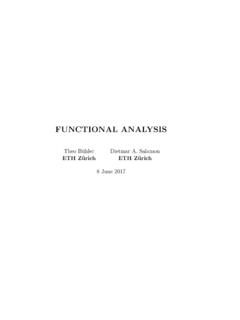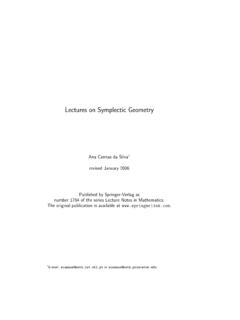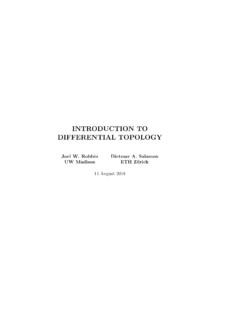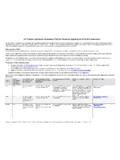Transcription of INTRODUCTION TO DIFFERENTIAL GEOMETRY - ETH Z
1 INTRODUCTION TODIFFERENTIAL GEOMETRYJoel W. RobbinUW MadisonDietmar A. SalamonETH Z urich19 December 2021iiPrefaceThese are notes for the lecture course DIFFERENTIAL GEOMETRY I given by thesecond author at ETH Z urich in the fall semester 2017 . They are based ona lecture course1given by the first author at the University of Wisconsin Madison in the fall semester can distinguishextrinsic DIFFERENTIAL geometryandintrinsic differ-ential GEOMETRY . The former restricts attention to submanifolds of Euclideanspace while the latter studies manifolds equipped with a Riemannian extrinsic theory is more accessible because we can visualize curves andsurfaces inR3, but some topics can best be handled with the intrinsic definitions in Chapter 2 have been worded in such a way that it is easyto read them either extrinsically or intrinsically and the subsequent chaptersare mostly (but not entirely) extrinsic. One can teach a self contained onesemester course in extrinsic DIFFERENTIAL GEOMETRY by starting with Chapter 2and skipping the sections marked with an asterisk such as is a description of the content of the book, chapter by 1 gives a brief historical INTRODUCTION to DIFFERENTIAL GEOMETRY andexplains the extrinsic versus the intrinsic viewpoint of the was not included in the lecture course at mathematical treatment of the field begins in earnest in Chapter 2,which introduces the foundational concepts used in DIFFERENTIAL geometryand topology.
2 It begins by defining manifolds in the extrinsic setting assmooth submanifolds of Euclidean space, and then moves on to tangentspaces, submanifolds and embeddings, and vector fields and includes an INTRODUCTION to Lie groups in the extrinsic setting and aproof of the Closed Subgroup Theorem. It then discusses vector bundles andsubmersions and proves the Theorem of Frobenius. The last two sectionsdeal with the intrinsic setting and can be skipped at first DIFFERENTIAL Geometry2It is shown in how any topological atlas on a set induces a sign convention for the Lie bracket of vector fields is explained in 3 introduces the Levi-Civita connection as covariant derivativesof vector fields along continues with parallel transport, introducesmotions without sliding, twisting, and wobbling, and proves the Develop-ment Theorem. It also characterizes the Levi-Civita connection in terms ofthe Christoffel symbols.
3 The last section introduces Riemannian metrics inthe intrinsic setting, establishes their existence, and characterizes the Levi-Civita connection as the unique torsion-free Riemannian connection on thetangent 4 defines geodesics as critical points of the energy functional andintroduces the distance function defined in terms of the lengths of curves. Itthen examines the exponential map, establishes the local existence of min-imal geodesics, and proves the existence of geodesically convex neighbor-hoods. A highlight of this chapter is the proof of the Hopf Rinow Theoremand of the equivalence of geodesic and metric completeness. The last sectionshows how these concepts and results carry over to the intrinsic 5 introduces isometries and the Riemann curvature tensor andproves the Generalized Theorema Egregium, which asserts that isometriespreserve geodesics, the covariant derivative, and the 6 contains some answers to what can be viewed as the funda-mental problem of DIFFERENTIAL GEOMETRY : When are two manifolds isometric?
4 The central tool for answering this question is the Cartan Ambrose HicksTheorem, which etablishes necessary and sufficient conditions for the exis-tence of a (local) isometry between two Riemannian manifolds. The chapterthen moves on to examine flat spaces, symmetric spaces, and constant sec-tional curvature manifolds. It also includes a discussion of manifolds withnonpositive sectional curvature, proofs of the Cartan Hadamard Theoremand of Cartan s Fixed Point Theorem, and as the main example a discussionof the space of positive definite symmetric matrices equipped with a naturalRiemannian metric of nonpositive sectional is the point at which the ETH lecture course ended. However,Chapter 6 contains some additional material such as a proof of the Bonnet Myers Theorem about manifolds with positive Ricci curvature, and it endswith brief discussions of the scalar curvature and the Weyl logical progression of the book up to this point is linear in thatevery chapter builds on the material of the previous one, and so no chaptercan be skipped except for the first.
5 What can be skipped at first readingare only the sections labelled with an asterisk that carry over the variousnotions introduced in the extrinsic setting to the intrinsic covariant derivative of a global vector field is deferred to 7 deals with various specific topics that are at the heart of thesubject but go beyond the scope of a one semester lecture course. It beginswith a section on conjugate points and the Morse Index Theorem, whichfollows on naturally from Chapter 4 about geodesics. These results in turnare used in the proof of continuity of the injectivity radius in the secondsection. The third section builds on Chapter 5 on isometries and the Rie-mann curvature tensor. It contains a proof of the Myers Steenrod Theorem,which asserts that the group of isometries is always a finite-dimensional Liegroup. The fourth section examines the special case of the isometry group ofa compact Lie group equipped with a bi-invariant Riemannian metric.
6 Thelast two sections are devoted to Donaldson s DIFFERENTIAL geometric approachto Lie algebra theory as explained in [17]. They build on all the previouschapters and especially on the material in Chapter 6 about manifolds withnonpositive sectional curvature. The fifth section establishes conditions un-der which a convex function on a Hadamard manifold has a critical last section uses these results to show that the Killing form on a simpleLie algebra is nondegenerate, to establish uniqueness up to conjugation ofmaximal compact subgroups of the automorphism group of a semisimple Liealgebra, and to prove Cartan s theorem about the compact real form of asemisimple complex Lie appendix contains brief discussions of some fundamental notions ofanalysis such as maps and functions, normal forms, and Euclidean spaces,that play a central role throughout this thank everyone who pointed out errors or typos in earlier versions ofthis book. In particular, we thank Charel Antony and Samuel Trautwein formany helpful comments.
7 We also thank Daniel Grieser for his constructivesuggestions concerning the August 2021 Joel W. Robbin and Dietmar A. SalamonviContents1 What is DIFFERENTIAL GEOMETRY ? Cartography and DIFFERENTIAL GEOMETRY .. Coordinates .. Topological Manifolds* .. Smooth Manifolds Defined* .. The Master Plan .. 132 Submanifolds of Euclidean Space .. Tangent Spaces and Derivatives .. Space .. Inverse Function Theorem .. Submanifolds and Embeddings .. Vector Fields and Flows .. Fields .. Flow of a Vector Field .. Lie Bracket .. Lie Groups .. and Examples .. Lie Algebra of a Lie Group .. Group Homomorphisms .. Subgroups .. Groups and Diffeomorphisms .. Maps and Algebra Homomorphisms .. Fields and Derivations .. Vector Bundles and Submersions .. Bundles .. The Theorem of Frobenius.
8 The Intrinsic Definition of a Manifold* .. and Examples .. Maps and Diffeomorphisms .. Spaces and Derivatives .. and Embeddings .. Bundle and Vector Fields .. Notation .. Consequences of Paracompactness* .. of Unity .. in Euclidean Space .. of a Foliation .. Bundles .. 1143 The Levi-Civita Second Fundamental Form .. Covariant Derivative .. Parallel Transport .. The Frame Bundle .. of a Vector Space .. Frame Bundle .. Lifts .. Motions and Developments .. and Wobbling .. Christoffel Symbols .. Riemannian Metrics* .. of Riemannian Metrics .. Examples .. Levi-Civita Connection .. Vector Fields in the Intrinsic Setting .. 1734 Length and Energy .. Length and Energy Functionals .. Space of Paths .. of Geodesics .. Distance .. The Exponential Map .. Spray.
9 Exponential Map .. and Exercises .. Minimal Geodesics .. of Minimal Geodesics .. Existence of Minimal Geodesics .. and Exercises .. Convex Neighborhoods .. Completeness and Hopf Rinow .. Geodesics in the Intrinsic Setting* .. Distance .. and the Levi-Civita Connection .. and Exercises .. 2205 Isometries .. The Riemann Curvature Tensor .. and Gau Codazzi .. Derivative of a Global Vector Field .. Global Formula .. Metrics on Lie Groups .. Generalized Theorema Egregium .. Egregium .. ian Curvature .. Curvature in Local Coordinates* .. 2546 GEOMETRY and The Cartan Ambrose Hicks Theorem .. Global C-A-H Theorem .. Local C-A-H Theorem .. Flat Spaces .. Symmetric Spaces .. Spaces .. Derivative of the Curvature .. and Exercises .. Constant Curvature .. Curvature .. Sectional Curvature.
10 Space .. Nonpositive Sectional Curvature .. Cartan Hadamard Theorem .. s Fixed Point Theorem .. Definite Symmetric Matrices .. Positive Ricci Curvature* .. Scalar Curvature* .. The Weyl Tensor* .. 3197 Topics in Conjugate Points and the Morse Index* .. The Injectivity Radius* .. The Group of Isometries* .. Myers Steenrod Theorem .. Topology on the Space of Isometries .. Vector Fields .. of the Myers Steenrod Theorem .. and Exercises .. Isometries of Compact Lie Groups* .. Convex Functions on Hadamard Manifolds* .. Functions and The Sphere at Infinity .. Products and Weighted Flags .. of Vectors .. Semisimple Lie Algebras* .. Inner Products .. Lie Algebras .. Lie Algebras .. Lie Algebras .. 404A Maps and Functions .. Normal Forms .. Euclidean Spaces .. 414 References417 Index423 Chapter 1 What is DifferentialGeometry?





